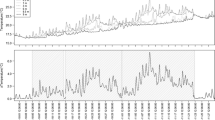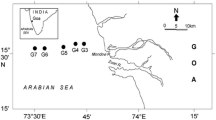Abstract
We investigated the effects of sulfate concentration on sulfate reduction and net S storage in lake sediments using34S as a tracer. The water overlying intact sediment cores from the hypolimnion of Mares Pond, MA, was replaced with two Na2 34SO4 solutions at either ambient (70 μM) or elevated (260 μM) sulfate concentrations. The δ34S of the added sulfate was 4974 ‰. Over two months, the net sulfate reduction rate in the ambient sulfate treatment was zero, while the net rate for the high sulfate treatment was 140 μmoles/m2/d. The water overlying the cores was kept under oxic conditions and the sediment received no fresh carbon inputs, thus the net rate reported may underestimate the in situ rate. Gross sulfate reduction rates calculated by isotope dilution were approximately 350 μmoles/m2/d for both treatments. While the calculation of gross sulfate reduction rates in intact sediment cores can be complicated by differential diffusion of34S and32S, isotopic fractionation, and the possible formation of ester sulfates, we believe these effects to be small. The results suggest that sulfate reduction is not strongly sulfate-limited in Mares Pond. The difference in net sulfate reduction rates between treatments resulted from a decrease in sulfide oxidation and suggests the importance of reoxidation in controlling net S storage in lake sediments. In both treatments the CRS and organic S fractions were measurably labelled in34S. Below the sediment surface, the CRS fraction was the more heavily labelled storage product for reduced sulfides.
Similar content being viewed by others
References
Blackburn TH (1979) Method for measuring rates of NH4 + turnover in anoxic marine sediments, using a15N-NH4 + dilution technique. Appl. Environm. Microbiol. 37: 760–765
Bowden WB (1984) A nitrogen-15 isotope dilution study of ammonium production and consumption in a marsh sediment. Limnol. Oceanogr. 29: 1004–1015
Carignan R (1985) Quantitative importance of alkalinity flux from the sediments of acid lakes. Nature 317: 158–160.
Carignan R & Tessier A (1988) The co-digensis of S and iron in acid lake sediments of southwestern Quebec. Geochim. Cosmochim. Acta 52: 1179–1188
Chanton JP, Martens CS & Goldhaber MB (1987) Biogeochemical cycling in an organic-rich coastal basin. 8. A S isotopic budget balanced by differential diffusion across the sediment-water interface. Geochim. Cosmochim. Acta 51: 1201–1208
Cook RB (1981) The biogeochemistry of S in two small lakes. Ph.D. dissertation, Columbia University, New York. 234 pp
Cook RB & Schindler DW (1983) The biogeochemistry of S in an experimentally acidified lake. In R. Hallberg (ed): Environmental Biogeochemistry Ecol. Bull. 35: 115–127
David MB & Mitchell MJ (1985) Sulfur constituents and cycling in waters, seston, and sediments of an oligotrophic lake. Limnol. Oceanogr. 30: 1196–1207
Dornblaser MM, Tucker J, Banta GT, Foreman KH, O'Brien MC & Giblin AE (1989) Obtaining undisturbed sediment cores for biogeochemical process studies using SCUBA. In: Diving for Science 1989. Proc. Am. Acad. Underwater Sci. pp 97–104
Fry B (1986) Stables S isotopic distributions and sulfate reduction in lake sediments of the Adirondack Mountains, New York. Biogeochemistry 2: 329–343
Giblin AE, Likens GE, White D & Howarth RW (1990) S storage and alkalinity generation in New England Lake sediments. Limnol. Oceanogr. 35: 852–869
Gorham E, Lund JWG, Sanger JE & Dean WD Jr (1974) Some relationships between algal standing crop, water chemistry, and sediment chemistry in English lakes. Limnol. Oceanogr. 19: 601–617
Holdren GR, Brunelle TM, Matisoff G & Whalen M (1984) Timing the increase in atmospheric sulphur deposition in the Adirondack Mountains. Nature 311: 245–247
Howarth RW & Merkel S (1984) Pyrite formation and the measurements of sulfate reduction in salt marsh sediments. Limnol. Oceanogr. 29: 598–608
Jorgensen BB (1977) The S cycle of a coastal marine sediment (Limfjorden, Denmark). Limnol. Oceanogr. 22: 814–832
Kelly CA & Rudd JWM (1984) Epilimnetic sulfate reduction and its relationship to lake acidification. Biogeochemistry 1: 63–77
Kling GW, Giblin AE, Fry B & Peterson BJ (1991) The role of seasonal turnover in lake alkalinity dynamics. Limnol. Oceanogr. 36: 106–122
Landers DH & Mitchell MJ (1988) Incorporation of35SO4 −2 into sediments of three New York Lakes. Hydrobiologia 160: 85–95
Matrosov AG, Chebotarev EN, Kudryavtseva AJ, Zyakun AM & Ivanov MV (1975) S isotope composition in fresh-water lakes containing H2S. Geochim. Int. 12: 217–221
Mitchell MJ, Owen JS & Schindler SC (1990) Factors affecting S incorporation into lake sediments: Paleoecological implications. J. Paleolimnology 4: 1–22
Mitchell MJ, Schindler SC, Owen JS & Norton SA (1988) Comparison of S concentrations within lake sediment profiles. Hydrobiologia 157: 219–229
Nriagu JO (1984) Role of inland water sediments as sinks for anthropogenic S. Sci. Total Environ. 38: 7–13
Nriagu JO & Soon YK (1985) Distribution and isotopic composition of S in lake sediments of northern Ontario. Geochim. Cosmochim. Acta 49: 823–834
Peterson BJ & Fry B (1987) Stable isotopes in ecosystem studies. Ann. Rev. Ecol. and Syst. 18: 293–320
Ramm AE & Bella DA (1974) Sulfide production in anaerobic microcosms. Limnol. Oceanogr. 19: 110–118
Rich PH (1980) Hypolimnetic metabolism in three Cape Cod lakes. Am. Mid. Nat. 104: 102–109
Rudd JWM, Kelly CA & Furutani A (1986) The role of sulfate reduction in long term accumulation of organic and inorganic S in lake sediments. Limnol. Oceanogr. 31: 1281–1292
Stumm W & Morgan JJ (1981) Aquatic Chemistry, 2nd ed., Wiley
Toran LR and Harris RF (1989) Interpretation of S and oxygen isotopes in biological and abiological sulfide oxidation. Geochimica Cosmochimica Acta 53: 2341–2348
White JR, Gubala CP, Fry B, Owen J & Mitchell MJ (1989) Sediment biogeochemistry of iron and S in an acid lake. Geochim. Cosmochim. Acta 53: 2547–2559
Yanagisawa F & Sakal H (1983) Thermal decomposition of barium sulfate-vanadium pentaoxidesilica glass mixtures for preparation of S dioxide in S isotope ratio measurements. Anal. Chem. 55: 985–987
Author information
Authors and Affiliations
Rights and permissions
About this article
Cite this article
Dornblaser, M., Giblin, A.E., Fry, B. et al. Effects of sulfate concentration in the overlying water on sulfate reduction and sulfur storage in lake sediments. Biogeochemistry 24, 129–144 (1994). https://doi.org/10.1007/BF00003269
Received:
Accepted:
Issue Date:
DOI: https://doi.org/10.1007/BF00003269




